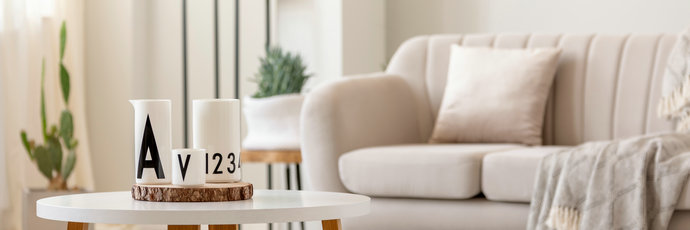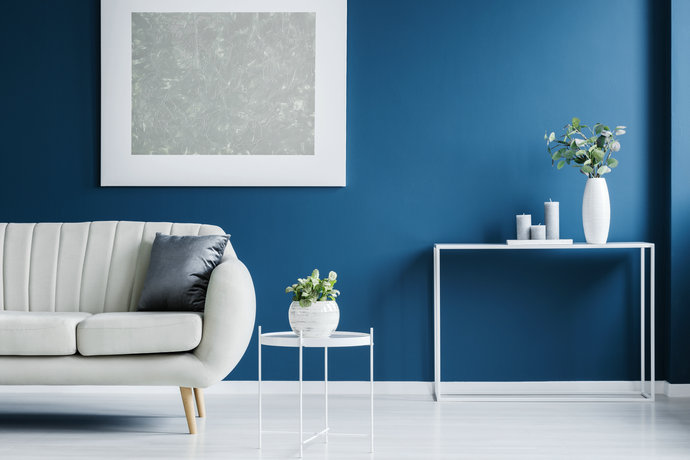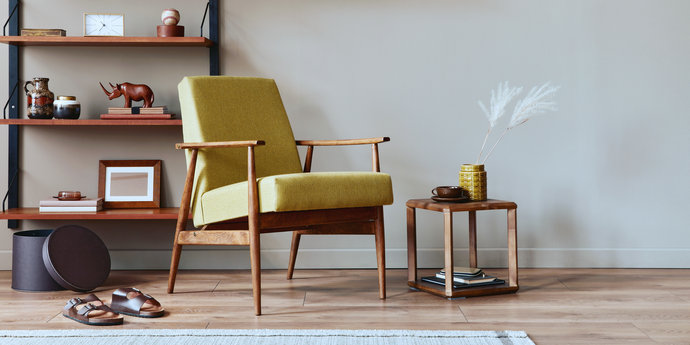
End tables, often seen gracing living spaces with both function and flair, can be a subtle yet pivotal component in bringing a room together. However, selecting the right one isn’t just about aesthetics; dimensions play a critical role. In the article, we delve into the intricacies of sizing these tables to ensure they fit seamlessly with your other furniture pieces. This guide will equip you with the knowledge to choose an end table that is proportionate to your space, aligns with your sofa or chair’s height, and suits your functional needs. Whether you’re revamping an existing space or setting up a new one, let’s decode the numbers behind the perfect end table size for you.
Exploration of End Table Styles
End tables come in many styles, so it’s important to consider various dimensions and design elements. In this section, we’ll discuss a few popular styles, such as contemporary and minimal designs.
Contemporary End Tables
Contemporary end tables often have clean lines and tend to be visually appealing due to their simple design. They typically range from 18 to 24 inches in height and have a width of 16 to 22 inches. Contemporary end tables can come in a variety of materials such as wood, glass, or metal and often feature unique details like geometric shapes or bold colors.
Minimal End Tables
Minimal end tables are perfect for those who prefer simplicity in their furniture. These tables usually focus on a basic yet functional design and often have sleek, straight lines. Just like contemporary end tables, they should be within two inches of your sofa’s arm height and range in width from 16 to 22 inches. Materials for minimal end tables could include wood, metal, or even a combination of both. The colors of these end tables tend to be more muted and neutral, making them an excellent choice for those seeking a clean, uncluttered look.
Functionality of End Tables

End tables are a great addition to your living space for various reasons. First and foremost, they provide a convenient surface for placing everyday items such as a table lamp or a cup of coffee. Moreover, they create a cozy atmosphere and enhance the functionality of your room.
An end table is perfect for placing your favorite table lamp to provide the right amount of light for evening reading or relaxation. It not only brightens up the corner but adds a touch of style to your room as well.
Additionally, end tables serve as a handy spot for your drinks and snacks while you’re enjoying some quality time on your couch. Imagine comfortably sipping your tea or digging into a bowl of popcorn without having to worry about spilling anything on your sofa.
End tables also offer storage options that can help declutter your living room. Depending on the design, they may include drawers and shelves, perfect for keeping smaller items such as books, magazines, and remote controls. This extra storage helps keep your space neat and organized.
In conclusion, end tables are both stylish and functional furniture pieces that enhance your living area by providing additional surface areas for various purposes like storing your essentials, displaying decorative items, and holding drinks and snacks during leisure time. So go ahead and find the right end table for your space and add that perfect touch of functionality to your space.
Balance and Aesthetic with End Tables
When choosing end tables for your living room, it’s essential to achieve a perfect balance of functionality and aesthetics. You want your end table to complement your sofa and other furniture, creating a harmonious living space.
A good starting point is to make sure your end table is within two inches of your sofa’s arm height. For example, if your couch’s arm is 18 inches tall, opt for an end table between 16 and 20 inches. This will not only ensure a comfortable and functional setup but also contribute to a cohesive look in your living room.
Achieving an aesthetically pleasing look involves selecting end tables that match your room’s style. Consider materials, colors, and design elements like table legs, drawer handles, or carvings. For a symmetrical look, try using two matching end tables on either side of your sofa. This creates a sense of balance and harmony in your space.
Incorporating mismatched end tables can also lead to an appealing balance. For example, you can have different shapes, sizes, or colors but maintain a common design feature or material. This will give your room an asymmetrical yet intentionally designed look, adding interest to your living space.
Lastly, think about the practical aspects of your end table. Make sure it’s the right size to accommodate items like lamps, books, and remote controls. You can choose from different widths, ranging from 16 to 22 inches. Wider tables provide more space, while smaller ones are perfect for compact areas.
End Table Dimensions
Standard End Table Dimension
It’s essential to consider the standard dimensions of the end table when you are looking for the perfect one to accompany your sofa or chair. Typically, end tables are 18 to 24 inches tall (1.5 to 2 feet), with an average width of 16 to 22 inches. The depth varies by style, but you can expect an average depth of 22 to 24 inches. To ensure a comfortable and functional setup, place the end table within 2 inches of your sofa’s arm height.
Small End Table Dimensions
If you have limited space or prefer a minimalist approach, small end tables can be an excellent choice. These tables are usually under 14 inches wide and work well with smaller sofas or chairs. Remember your available surface space when selecting a small end table, as you’ll need enough room to accommodate items like table lamps, books, or plants.
Shaker End Table Dimensions
Shaker end tables are a versatile option known for their simplicity and clean lines. These tables come in various sizes, but they generally follow the standard dimensions, around 18 to 24 inches in height and 16 to 22 inches in width. Due to their simple design, they easily blend with different furniture styles and can be a great addition to your living room or bedroom.
Bedroom End Table Dimensions
Bedroom end tables, also known as nightstands, play a crucial role in providing convenience and functionality in the bedroom. To ensure the ideal size for your bedroom, keep the height of the end table within 2 inches of your bed’s mattress height. The table’s width is typically around 16 to 22 inches, but consider your available space and storage needs when selecting the perfect dimensions for your bedroom setup.
Round Table Dimensions
Typically, the dimensions of round end tables can vary depending on their intended use and design. However, most standard round end tables’ height is between 22 to 26 inches. This height range ensures that the table aligns well with the arm of the average sofa or chair. It provides easy access for someone seated next to it. The diameter is generally between 18 to 24 inches. This size is large enough to hold a lamp, book, or a few decorative items without taking up too much floor space.
How Thick Should an End Table Top Be?

A friendly reminder that you should always keep in mind the design and the overall look of your living space when choosing an end table. The thickness of an end table top can be a crucial detail in determining the best table for your room.
One general rule to follow is to maintain a proportional balance between the thickness of the end table top and the height of your sofa’s arm. For instance, if your sofa’s arm stands at 18 inches, you’ll want an end table with a height between 16 and 20 inches. This keeps the harmony of your furniture pieces and creates a more pleasing visual effect.
In terms of thickness, there isn’t a one-size-fits-all approach, but a few guidelines can help. Most end table tops range between 0.5 to 1.5 inches thick. Thinner tops work well for tables that will hold lightweight items such as remotes, books, or small decorative pieces. Meanwhile, thicker tops are better suited if you plan to use the table for holding heavier items like lamps or large plants.
Still, other factors like material and construction can affect the table’s ability to withstand weight. Solid wood or metal end table tops tend to offer more stability and can be thinner without sacrificing strength. On the other hand, lighter materials like glass or MDF (medium-density fiberboard) should be thicker to provide more durability.
To help you make the right choice for your end table top, here are a few pointers:
- Consider the material: Choose a material that complements the rest of your furniture and can provide the necessary support and thickness for your intended use.
- Keep the balance: Aim for an end table top that is proportionate to your sofa’s arm height and doesn’t overpower the overall design of your living space.
- Think about usage: Do you plan to use the end table for decorative or practical purposes? Select a thickness that suits your needs.
Getting the Right Surface Area
For the Lamp
When choosing an end table for your lamp, it’s essential to consider the surface area needed to support your table lamp comfortably. A good rule of thumb is to search for an end table that’s at least 16 to 22 inches wide and about 18 to 24 inches tall, which allows enough space for both your lamp and other essentials. To ensure your lamp doesn’t overpower the space, consider the size of the lampshade and ensure it fits proportionally with the end table. This creates a well-balanced and functional space.
For the Books
End tables also serve as a perfect spot for your favorite books and reading materials. To accommodate these items, look for an end table that has ample surface area and additional storage options such as shelves or drawers. In this case, you might opt for a wider end table, around 22 to 24 inches deep, to provide enough space for your books while keeping the table top clutter-free. A well-organized end table enhances your reading experience and complements your room’s aesthetic.
Here are some tips for organizing your books on the end table:
- Stack them according to size, with larger books at the bottom and smaller ones on top.
- Arrange by color for a visually appealing display.
- Use bookends for added stability and style.
For the Drinks
A relaxing evening with your favorite drink in hand is made even better with a functional end table at your side. For this purpose, the end table should have a non-porous surface to prevent damage from spills or condensation. Consider these factors when choosing an end table to hold your drinks:
- Durability: Look for end tables made of sturdy materials, such as wood or metal.
- Surface area: Aim for a table 18 to 24 inches tall and 16 to 22 inches wide to accommodate your drink and any additional items you may need, like coasters or snacks.
- Easy to clean: Seek materials that are simple to wipe down, such as glass or polished wood.
Remember, by considering your specific needs for the surface area, you can find the perfect end table that accommodates your lamp, books, and drinks.
How to Measure an End Table by Yourself
Measuring the right end table size is a simple process that you can easily accomplish on your own. By following these straightforward steps, you’ll determine the dimensions you need for your end table, ensuring that it works perfectly with your space.
1. Determine the ideal height: To find the right end table height, you’ll want it to be within two inches of your sofa’s arm height. For example, if your couch’s arm is 18 inches high, look for an end table that’s between 16 and 20 inches tall. This helps create a balanced look and ensures easy access to items placed on the table.
2. Consider the width: The end table width will depend on the functionality you want it to offer. While the average width is usually between 16 and 22 inches, there’s no strict rule to follow. Think about what items you’d like to place on the table, such as lamps, books, or plants, and select a width that accommodates those items.
3. Measure the length: The length of an end table is typically between 14 and 24 inches, correlating with standard sofa sizes. When determining the appropriate length, consider the available space you have for the end table and how it complements the rest of your furniture.
To measure your end table’s dimensions, you’ll need a tape measure, pen, and paper to note down the measurements. Using these tools, follow these steps:
- Stand next to your sofa and measure its arm height, noting the measurement on the paper.
- Measure the widths of potential end tables, based on your functional needs.
- Measure the lengths of end tables, considering your available space and other furniture.
By following these guidelines and completing the measurements, you’ll be confident in selecting a new end table that fits perfectly with your sofa and living space. Enjoy the process, and good luck with your end table search!
Frequently Asked Questions:
What is the ideal height for an end table next to a chair?
The ideal height for an end table next to a chair should be within 2 inches of the chair’s armrest height. For example, if the chair arm is 24 inches high, the end table should be between 22 and 26 inches tall. This allows for comfortable and easy access to the items on the table while sitting in the chair.
What are the common bedside table dimensions?
Common bedside table dimensions range from 20 to 30 inches in height, 16 to 22 inches in width, and 16 to 22 inches in depth. Keep in mind that the size and style of your bed and bedroom can influence your choice of a bedside table. It’s important to consider the height of your bed and any storage needs when selecting a bedside table.
How do I choose the right size for a round side table?
To choose the right size for a round side table, consider both the size of the space you have available and the purpose of the table. A common guideline is to ensure the table height is within 2 inches of the seat height of nearby furniture. For the diameter, select a size that comfortably fits within your space, while still providing enough surface area for your needs.
How much space is recommended between a sofa and an end table?
The recommended space between a sofa and an end table is typically 1 to 2 feet. This allows for enough room to comfortably access the table and any items on it while sitting on the sofa. Moreover, it provides a balanced appearance in your living room layout.
What is the standard height for a table between two chairs?
The standard height for a table between two chairs should be within 2 inches of the chair’s armrest height, similar to an end table. If the chairs have different armrest heights, choose a table height that falls within the average of both heights. This ensures a functional and visually appealing setup.
Are there any standard dimensions for small end tables?
While there are no strict standard dimensions for small end tables, they typically range from 18 to 24 inches in height, with a width and depth of around 16 to 22 inches. The best size for your small end table will depend on the layout of your room and the specific purpose it serves. Remember to keep the table height within 2 inches of the nearby furniture’s seat or armrest height for optimal functionality.
